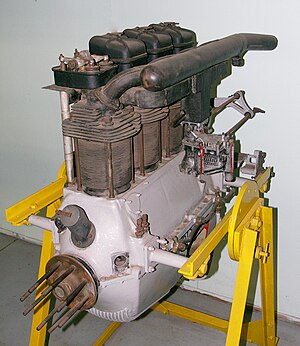Wright Gipsy
| Gipsy | |
|---|---|
 |
|
| Gipsy II | |
| Type | Four-cylinder inline piston engine |
| National origin | United Kingdom |
| Manufacturer | de Havilland |
| First run | 1927 |
| Major applications |
de Havilland D.H.60G Gipsy Moth de Havilland D.H.71 Tiger Moth racer |
| Developed into |
de Havilland Gipsy Major de Havilland Gipsy Minor |
The de Havilland Gipsy is a British air-cooled four-cylinder in-line aircraft engine designed by Frank Halford in 1927 to replace the ADC Cirrus in the de Havilland DH.60 Moth light biplane. Initially developed as an upright 5 litre (300 cubic inch) capacity engine, later versions were designed to run inverted with increased capacity and power.
The Gipsy went on to become one of the most popular sport aircraft engines of the inter-war period and was the engine of choice for various other light aircraft, trainers, liaison aircraft and air taxis, British as well as foreign, until long past World War II. Apart from helping to establish the de Havilland Aircraft Company as a manufacturer of light aircraft, it also established the company as an engine manufacturer in its own right.
Gipsy engines remain in service powering vintage light aircraft.
Just like the ADC Cirrus, the Gipsy was born as a collaboration between aircraft manufacturer Geoffrey de Havilland and engine designer Frank Halford. In fact, the early history of the Cirrus and Gipsy were linked through de Havilland's D.H.60 Moth.
In 1925 Geoffrey de Havilland was looking for a reliable cheap engine for use in a light sports aircraft. More particularly, he was looking for something like his favourite First World War aircraft engine: the 240 hp (180 kW) Renault 8G air-cooled V8, but with half the weight and half the power. Halford gave it to him by building a four-cylinder crankcase and adding to it half of the Renault's cylinders, several other of the Renault’s components, and standard parts used in car engines. The result was a 60 hp (45 kW) in-line aircraft engine that, although it fell short of the promised horse-power, was still superior to all contemporary engines for light aircraft. Most importantly it was a true aircraft engine at a time where its competitors were more often than not motorcycle engines adapted to running at high altitude. The engine secured, de Havilland Aircraft commenced manufacture of the D.H.60 Moth and the combination of reliable powerplant - the ADC Cirrus - and reliable training craft – the Moth - marked the start of serious sports flying in Britain.
...
Wikipedia
